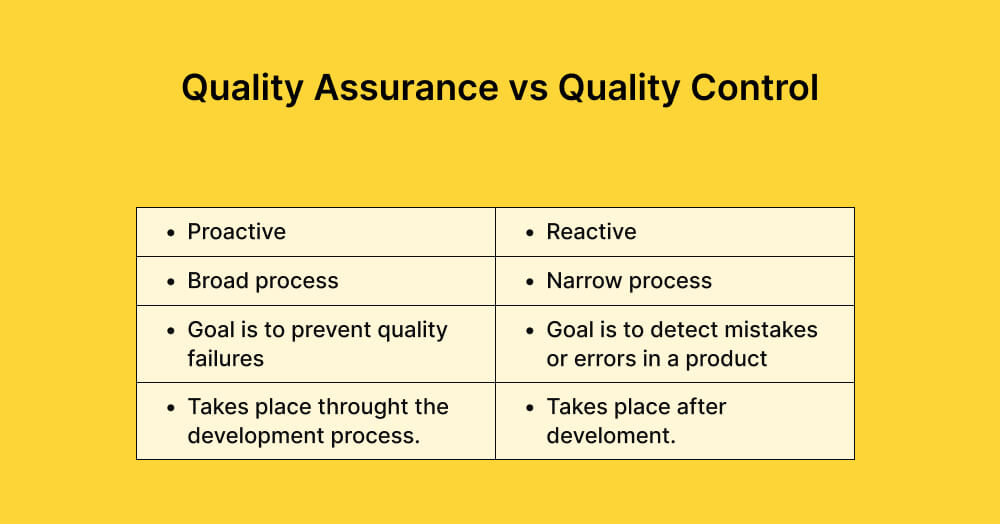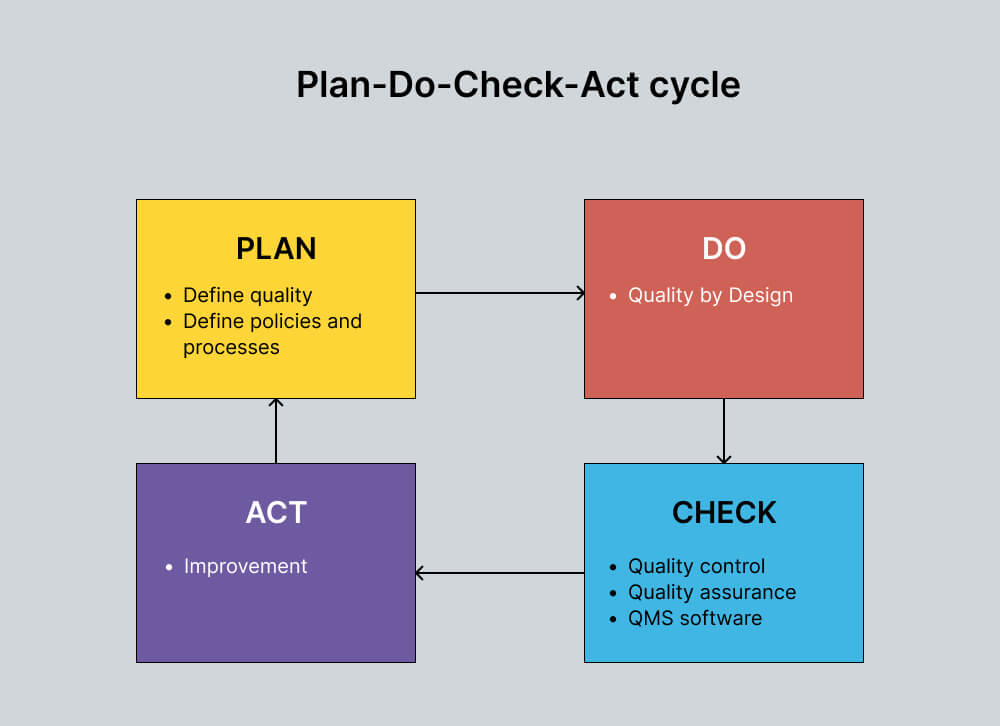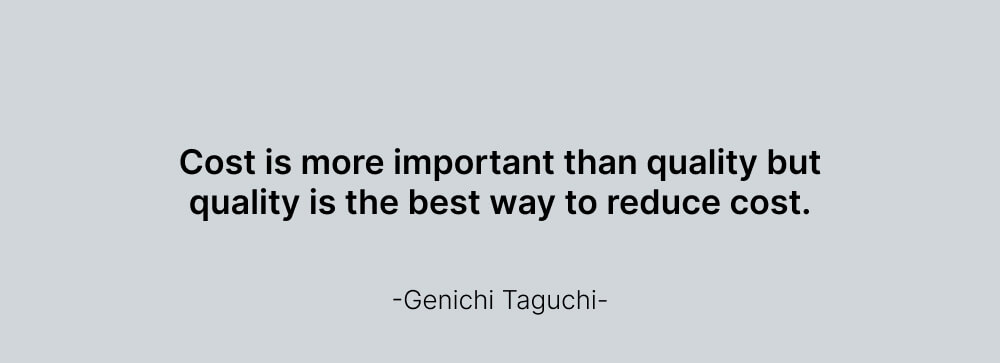Quality Assurance vs Quality Control
According to CISQU, the cost of poor software quality in the US reached at least $2.41 trillion in 2022. What adjustments in software development strategies can minimize the increasing financial impact of quality issues? Quality assurance and quality control are two processes that are essential to ensuring the production of high-quality products and services.
Understanding the differences between the two processes is crucial to maintaining high-quality standards within a company. This blog post will explore the differences between quality assurance and quality control and their significance in product development.
Join our community of 70,000+ testers around the globe and earn money testing websites and apps in your free time.
What is Quality assurance?
Quality assurance (QA) is a process that ensures that the products or services fulfill the required quality requirements and are free from defects or errors. It is part of any organization aiming to deliver high-quality products or services. Quality assurance also encompasses the activities carried out to avoid quality issues from occurring in the first place. It involves setting up processes that can be used to identify, measure, and analyze the quality of the products or services being delivered. Quality assurance also entails continuous monitoring and improvement of the processes utilized to ensure that the quality standards are always upheld.
What is Quality control?
Quality control (QC) is a process used to identify and correct defects or errors in the products or services being delivered. It entails inspecting and testing the products or services to ensure they meet the quality standards and specifications. Quality control activities are performed during production to ensure that the finished product is free from any defects or issues that may negatively impact its quality. Quality control also ensures that the products or services delivered are consistent and meet customer needs and expectations.
Quality Assurance vs Quality Control - Key differences
While the terms quality assurance and quality control are sometimes used together, there are essential differences between these two concepts:
- Quality assurance prevents quality issues from occurring in the first place. In contrast, quality control identifies and corrects defects or errors in finished products or services.
- Quality assurance is a proactive procedure that includes designing and implementing processes to ensure consistent quality in products or services. In contrast, quality control is a reactive process that involves checking products or services after they have been produced.
- Quality assurance is generally a broader concept encompassing quality control and other quality-related activities. In comparison, quality control is a narrower concept focusing solely on inspecting and testing finished products or services.
While the two concepts have similarities, understanding their key differences is critical to implementing effective quality management practices in any organization.

Benefits of QA and QC
Implementing quality assurance and quality control strategies in organizations offers several benefits critical to any business's overall success. These benefits include:- Quality assurance and control processes ensure consistent product or service quality, promoting customer satisfaction and loyalty.
- Quality assurance and quality control help cut production costs and minimize expenses related to product failures by preventing quality issues and ensuring products or services meet required standards.
- Organizations can effectively implement quality assurance and control processes to show customers their dedication to quality, establishing a robust reputation for delivering products or services that align with customer needs and expectations.
- Quality assurance and control processes enhance production efficiency by minimizing the time required to produce, inspect, and test products or services.
- Quality assurance and quality control processes facilitate continuous improvement by enabling organizations to identify and address quality issues, implement changes, and monitor the effect of those changes.

Quality Assurance vs Quality Control - Timeline
Having explored the differences and advantages of quality assurance and control, let's now examine the timelines associated with each.
Quality assurance process
The quality assurance process guarantees that products and services satisfy the necessary quality standards and that customer expectations are consistently met. The following steps are involved in the quality assurance process:
1. Define quality standards and requirements: The first stage identifies the quality standards and requirements for the provided product or service.
2. Design quality control processes: This step involves designing processes to monitor and control product or service quality. It includes identifying the necessary equipment, tools, and techniques to implement the processes effectively.
3. Implement quality control processes: The designed quality control processes are implemented during production to ensure that products or services consistently meet the appropriate quality standards.
4. Perform quality audits and inspections: The products or services are checked regularly to meet the necessary quality standards. It includes performing quality audits and inspections to identify defects or issues affecting product or service quality.
5. Continuously improve: The final step involves constantly improving the quality assurance process by analyzing data from quality audits, inspections, and customer feedback. This data is then used to identify areas for improvement and implement changes to the quality assurance process, enabling organizations to deliver products or services that consistently meet customer expectations.
Quality control process
The quality control process systematically identifies and corrects defects or errors in finished products or services, ensuring they meet the necessary quality standards and customer expectations. The following steps are involved in the quality control process:
1. Define quality standards and requirements: The first stage identifies the quality standards and requirements for the finished product or service.
2. Develop product or service specifications: This step involves developing product or service specifications that detail the necessary quality standards.
3. Develop quality control plans: This step involves developing plans for quality control activities that include inspection and testing of the finished product or service to ensure that it satisfies the required quality standards.
4. Implement quality control activities: These activities are implemented during the production process, and they involve data collection and analysis, inspection, and testing to ensure that the finished product or service meets the necessary quality standards.
5. Analyze data and identify defects: Data collected from quality control activities is analyzed, and any defects or issues are identified and corrected.
6. Take corrective action: This step involves addressing defects or issues identified during quality control activities and preventing future occurrences.
Quality Assurance vs Quality Control - Approaches
With a detailed understanding of the timelines associated with quality assurance and quality control, let's turn our attention to the varied approaches adopted by each.
Quality assurance approaches
Quality assurance approaches are the different methods that organizations can use to ensure that their products or services meet the quality standards and customer expectations. The following are some quality assurance approaches:
1. Total Quality Management (TQM) focuses on continual development and incorporates all personnel in the organization into the quality process.
2. Six Sigma emphasizes using statistical methods and data analysis to minimize defects and improve the quality of the products or services.
3. The plan-do-check-act (PDCA) or Deming cycle is a quality assurance approach involving continuous improvement through four stages: planning, implementing, monitoring and reviewing, and modifying or adjusting based on the results.
4. Lean Manufacturing involves reducing waste and increasing efficiency in the production process to improve product quality.
5. Theory of Constraints (TOC) involves identifying and resolving the bottleneck in the production process to improve product quality.
6. Agile Methodology focuses on the delivery of high-quality software products through the use of progressive and iterative development processes.
7. ISO Standards Compliance (e.g., ISO 9001), which implements and maintains compliance with ISO standards, is a common approach to QA. These standards provide a framework of requirements for organizations to ensure that they consistently meet customer and regulatory requirements and continually improve.
Quality control approaches
Quality control approaches refer to the various methods organizations can use to identify and correct defects or errors in finished products or services. Some examples of quality control approaches are:
1. Statistical Process Control (SPC) involves using statistical techniques to monitor product quality during production and immediately detect deviations from the expected standards.
2. The Taguchi method is a quality control approach named after engineer Genichi Taguchi. This approach emphasizes statistical methods in product design and development to ensure that products are designed to resist sources of variation and perform well even under adverse conditions.
3. Inspection is a quality control approach that involves checking the finished product or service to ensure it meets the necessary quality standards. This approach involves visual, physical, or automated inspection methods.
4. Quality circles are group activities where employees come together voluntarily to identify and correct defects or errors in the production process and improve product quality.
5. Checklists are quality control approaches that involve creating a list of quality criteria and checking off each item, ensuring that products or services meet the necessary quality standards.
Conclusion
Quality assurance and quality control are crucial to an effective quality management system. Although both concepts are related to ensuring the quality of a product or service, they differ in their scope and focus. Quality control aims to identify defects or issues with a product or service, while quality assurance aims to prevent those defects from occurring in the first place. By implementing effective quality control and quality assurance practices, businesses can increase customer satisfaction, reduce costs, and improve the reliability of their products or services.
How can Global App Testing improve the quality of your product?
Global App Testing is a platform for app testing services that can help businesses improve the quality of their products in various ways. Here are a few ways Global App Testing can be beneficial:
Comprehensive testing: with 90,000 testers in 190+ countries, Global App Testing conducts thorough testing on diverse devices and platforms to identify app bugs and glitches.
Quick feedback: Swift test result feedback delivery, enabling developers to update and fix bugs and promptly enhance the user experience.
Real-world scenarios: Utilize real-world testers who simulate user behavior, identifying potential issues with the app's interface, usability, and other aspects.
Cost-effective: Aid businesses in saving money by identifying and addressing issues early and preventing costly fixes.
Quality Assurance at Various Stages: Assisting in identifying and fixing issues from early development to nearing launch.
Integration with Development Workflows: Integrate with your development workflows and tools, aligning with project management and bug-tracking systems for an efficient testing process.
If you want to learn more about how GAT can help you improve the quality of your software, sign up and set up a call with our team!
We can help you drive localization as a key initiative aligned to your business goals
FAQ
What is software quality assurance?
Software quality assurance is a process that ensures software products meet specified requirements and are free of errors.
Why is testing important in software development?
Testing is important in software development because it helps find and solve errors early in development, lowering the cost and time required to correct them later.
What does software quality assurance include?
Software quality assurance includes the entire software development process, from requirements gathering and design to project management, testing, and documentation, to ensure that software products meet specified quality standards.
Keep learning
How to Ensure Quality in the Software You Create?
Web app testing - everything you need to know
The 9 most common software testing mistakes you should avoid

.jpg)